After Decades, Tenants Are Still Fighting NYC Public Housing for Speedy Mold Relief
In the 1990s, they organized. In 2013, they sued. In 2023, residents continue the fight for safe homes in NYCHA developments across the city.
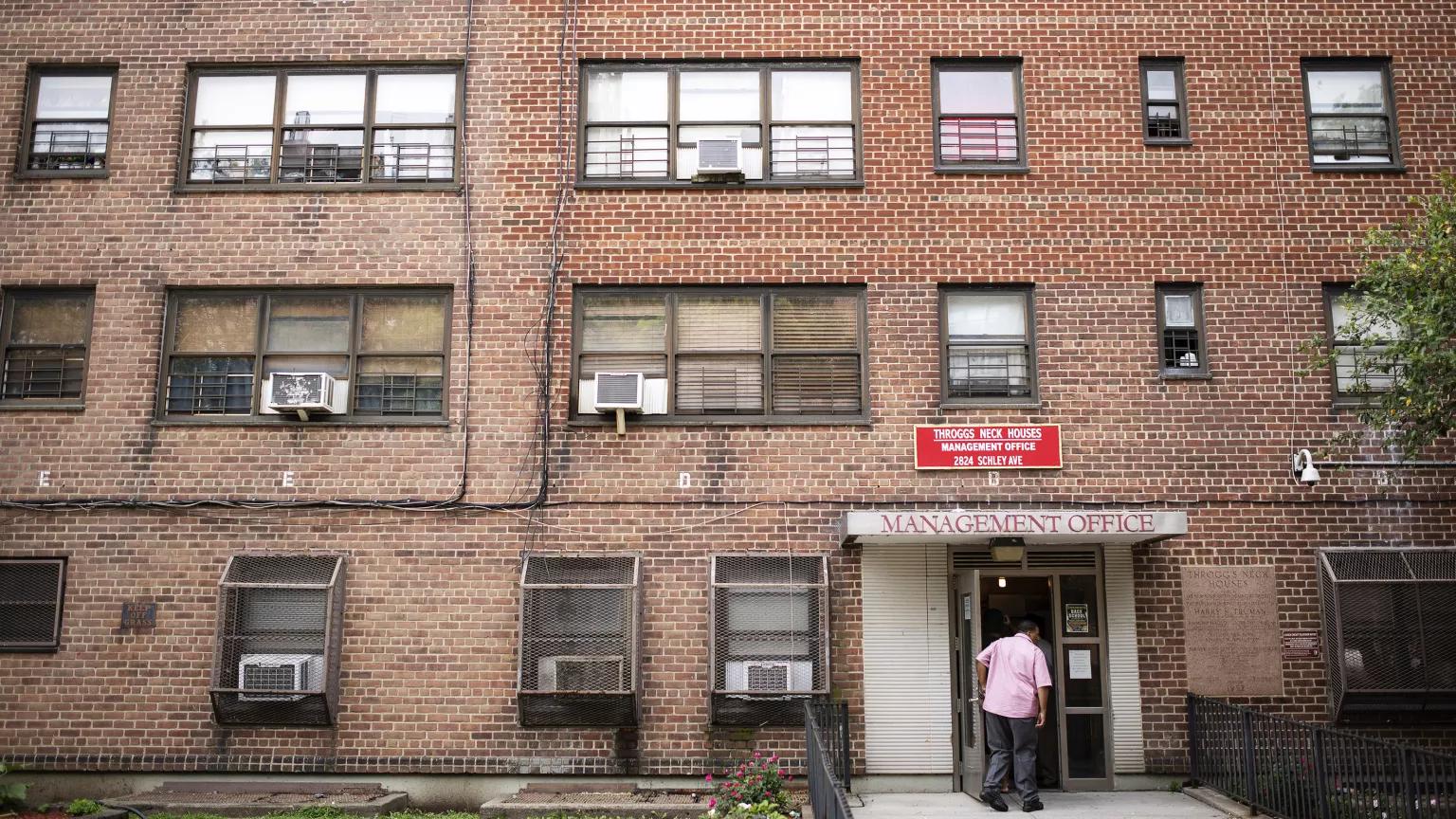
The Throggs Neck public housing development, in New York City on August 27, 2018
Karsten Moran/The New York Times/Redux
Reverend Getulio Cruz Jr.’s influence extends far beyond the walls of Monte Sion Christian Church in New York City’s East Village neighborhood. In the late 1990s, he began helping congregants who lived in public housing to make complaints to the city about unsafe conditions in their buildings. Excessive moisture and toxic mold plagued the apartments of several members of this small pentecostal community.
Cruz, or Pastor Getty as he is known to his community, helped found Manhattan Together, a network of congregations in the borough, in 2007, and soon began organizing for safer housing with South Bronx Churches and six other groups from across the region. Together, they linked up with the Metro Industrial Areas Foundation (Metro-IAF) and, in 2013, with the help of NRDC and the National Center for Law and Economic Justice, they filed a class action lawsuit against the New York City Housing Authority (NYCHA).
Baez v. New York City Housing Authority made the argument that the housing authority’s inadequate mold remediation policies violated the Americans with Disabilities Act, which covers asthma—a respiratory condition exacerbated by mold. The parties reached a settlement agreement the following spring that NYCHA would be responsible for remediating its tenants’ mold and moisture problems in a timely fashion.
In the years since, progress has been uneven. NYCHA failed to fulfill its obligations under the settlement agreement, leading the coalition partners to head back to court—first in 2015 to enforce the original settlement agreement and again in 2018. A federal judge approved a revised settlement agreement and appointed independent data and mold analysts (Neil Steinkamp and Bill Sothern, respectively) as well as an independent ombudsperson, César de Castro. Through the Mold and Leak Ombudsperson Call Center (OCC), all NYCHA residents across New York City gained an ally with the power to address their concerns about repairs that the agency has not completed properly or on time. Over the last three years, the OCC has overseen completion of more than 90,000 work orders, resolving escalated mold and leak complaints for more than 17,500 tenants.

A resident walks through her NYCHA apartment, which is contaminated with mold. The Baez suit launched soon after, in 2013.
Courtesy of Ana Brigida
According to an internal report that NYCHA filed with the court in June 2023, the rate of repair requests has slowed by half, from an average of 2,400 to 1,200 per month. That’s good news regarding new work orders, but NYCHA has yet to resolve a big backlog of older repair cases: In April, they numbered 90,589.
Given the housing authority’s track record, many tenants are wary about repair promises. Some are even skeptical about the OCC’s independence from NYCHA, believing it presents yet another false-hope solution. And that’s if they even know about it. Knowledge of the OCC resource is not as widespread as it should be, which is why community leaders like Cruz and residents like Bernard Smith are trying to educate as many NYCHA tenants as they can through informational materials and a series of in-person meetings.
To reflect back on the progress and the struggles residents have seen in the decade since the Baez lawsuit, and the challenges that lie ahead, community leaders and organizers, attorneys, and NYCHA tenants recently spoke with oral historian Phillip Norman. The project, made possible with support from Humanities New York, affirms that their fight for justice and safe, affordable housing will continue.
Ten years after the filing of Baez v. New York City Housing Authority oral historian Phillip Norman documents reflections from community organizers and attorneys and shares “stories of NYCHA tenants fighting to live and breathe better in the places they call home.”
All the interviews from this project can be accessed here.
Past: Suffering, collaboration, and hope
Even from their different vantage points, NYCHA residents, community organizers, and environmental lawyers all saw the same problem unfolding: systemic neglect. The housing agency was working too slowly, approaching the growing mold issue like a game of Whac-a-Mole instead of pursuing a systematic approach that would bring relief to the thousands of residents struggling with the same hazardous conditions.
Maria Roman remembers a time before circles of mold would bloom on the bathroom ceilings and paint chips would peel off the walls as leaky pipes went unattended. The Manhattan Together leader from Our Lady of Sorrows Church has been a resident of Baruch Houses on Manhattan's Lower East Side for more than 50 years.
“NYCHA used to be different. They used to come every year to inspect the apartments. They would look around. The people who fixed the stuff in your apartment worked in the same office, in the same neighborhood. So you knew who it was, you knew who they were.”
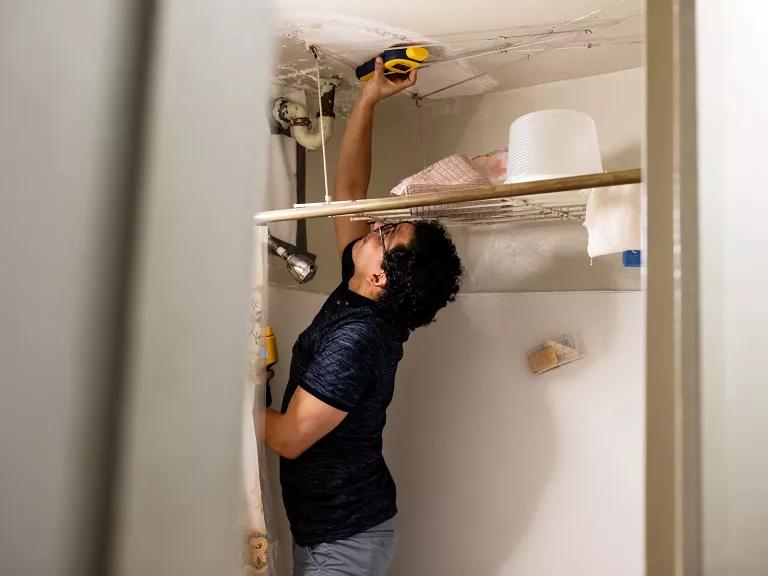
Ray Lopez reads the level of moisture in the bathroom ceiling of an apartment in Taft, a NYCHA building, on June 19, 2018.
Demetrius Freeman for NRDC
But that era of attentiveness didn’t last, Roman says. Disinvestment and mismanagement began to overwhelm NYCHA, and things started to slip. By the time Ray Lopez started working in East Harlem’s public housing complexes in 2001, he could tell right away that NYCHA officials were in over their heads when it came to taking care of tenants. As a leader on an asthma project organized by the East Harlem–based Little Sisters of the Assumption Family Health Service, his task was to conduct comprehensive home environmental assessments, take note of any conditions that could exacerbate a resident’s asthma, and then work with impacted families to make improvements.
The suffering was palpable. “Most parents, if not all, were doing everything they could to keep their children healthy.” Lopez recalls. “They didn't want to end up in the emergency room. Many of the kids did, and some of them were even hospitalized, and all of it just seemed completely preventable if the landlord or housing provider actually fulfilled their duty by providing habitable housing.”
Lopez says the "one family at a time approach” just wasn’t working. He brought his concerns to his supervisors, explaining how so many families were suffering from the same culture of neglect at NYCHA. “I want to be able to make sure that the systems that put people in these situations are responsive,” he says he told them.
Sara Imperiale, an attorney who directs litigation for NRDC’s Environment, Equity & Justice Center, shared Lopez’s concerns. Community advocates initially brought in Imperiale and her colleagues to help identify a legal strategy that could support housing authority–wide improvements for residents. Together with senior attorney Nancy Marks, Imperiale got to know residents through community roundtables and other meetings organized by Manhattan Together and South Bronx Churches. There, the people shared stories of breathing problems, headaches, nausea, and other health conditions that they traced back to the rampant mold and leaks in their apartments.
Sara Imperiale, director of litigation in NRDC’s Environment, Equity & Justice Center. | Image credits from start to finish: Courtesy of Sarah Imperiale; Demetrius Freeman for NRDC; all others courtesy of Ana Brigida
Present: Learning accountability
Throughout their decades-long fight and over the last 10 years since filing the federal lawsuit, the Metro-IAF organizers always kept their community front of mind. With more than half a million New Yorkers living in the network of NYCHA-run public housing developments, they knew they could not afford to acquiesce. Close to 90,000 of those residents live in nearly 42,000 apartments in the Bronx, where 8 percent of children already suffer from chronic lung disease. Meanwhile, asthma rates in the South Bronx are eight times the national average, due in part to the area’s poor air quality.
As Steinkamp, the case’s independent data expert, reflects, the creation of the OCC brought some welcome relief for many residents who were suffering in silence. “The brilliance of the OCC is not just that it gives voice to the tenants—which, to me, is an incredibly important aspect of it—but every OCC case is a moment to stop and think, Are there other people who are experiencing that? Again, the scale of NYCHA is so large that if you have one person who calls and says, ‘I'm experiencing this thing,’ there are usually ways to look in the data to see how many other people are experiencing that same thing.”
Bernard Smith, a leader at South Bronx Churches and a resident of Morris Houses in the Bronx for more than 50 years | First image courtesy of Jerry Bruck; all others, courtesy of Ana Brigida
Cruz credits the decrease in mold-related work orders to a successful partnership between the ombudsperson, the data analyst, and the mold analyst. “Working together, they're able to hold NYCHA accountable,” he says. “They hold the workers more accountable, they're taking a lot of the things that we've brought up over the years more seriously.”
Future: Continuing to speak out
Even with all the work left to be done, Cruz feels hopeful that his and the other organizers’ efforts have finally led to some meaningful change—not just for those immediately suffering from mold but for any NYCHA resident seeking assistance for, say, rodent infestations or broken appliances.
And he feels indebted to so many other individuals who helped build political power and pursue justice alongside the residents. These include leaders like Father Francis Skelly, a priest with Immaculate Conception Church and a founder of South Bronx Churches, and longtime organizers like Michael Stanley, who dove into the research and organized the tenants to hold NYCHA accountable.
Reverend Getulio Cruz Jr., a founding leader of Manhattan Together from Monte Sion Christian Church | All images by Demetrius Freeman for NRDC
The activists don’t mince words—this is going to continue to be an uphill battle, they say. They’re discouraged by the fact that it takes some 301 days, on average, to complete mold-related repairs, with plumbers and painters needing to be called in. Even for these “complex” cases, which typically require multiple visits, NYCHA’s remediation procedure claims to “make best efforts to complete the repairs within 15 days.”
Yet the progress so far has only reinforced the value of grassroots activism. “You got to talk,” says Sylvia Agosto, a Manhattan Together leader from Our Lady of Sorrows Church and a resident of Baruch Houses for more than 50 years. “You cannot shut down. If you're thinking of something, and you know you're right, just speak out. Speak out.”
This NRDC.org story is available for online republication by news media outlets or nonprofits under these conditions: The writer(s) must be credited with a byline; you must note prominently that the story was originally published by NRDC.org and link to the original; the story cannot be edited (beyond simple things such as grammar); you can’t resell the story in any form or grant republishing rights to other outlets; you can’t republish our material wholesale or automatically—you need to select stories individually; you can’t republish the photos or graphics on our site without specific permission; you should drop us a note to let us know when you’ve used one of our stories.
Submit a mold or leak complaint
If you have contacted your property manager about mold or leak issues but still have concerns, the Mold and Leak Ombudsperson Call Center is available for residents of NYCHA buildings.

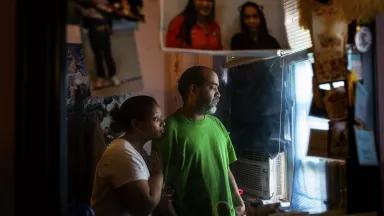
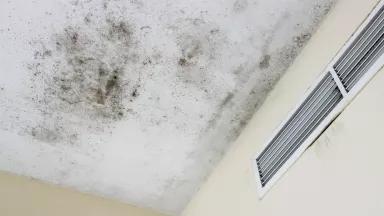
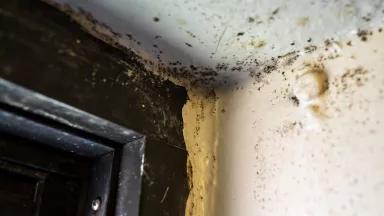


How Rikers Island Became a Vehicle for Justice (Once It Started Shutting Down)
A Translator for the Climate Crisis, Grief Included
Mount Vernon: Where Environmental Injustice Became a Sewage Nightmare